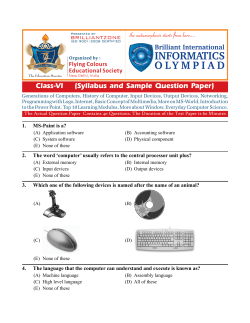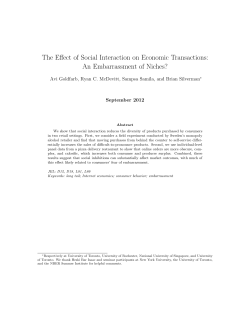
Paper - Embarrassing Interactions
Embarrassing to Collaborate? Abstract Robb Mitchell Fourth Author University of Southern Denmark YetAnotherCo, Inc. Kolding 6000 DK 123 YetAnother Ave. robb@mci.sdu.dk YetAnothertown, PA 54321 USA author4@yetanotherco.com Second Author Figure 1. Revellers struggle with a grid of cable-tied hula-hoops released on them at the climax of a Domino Records Showcase VP, Authoring Fifth Author Authorship Holdings, Ltd. AuthorCo, Inc. Authors Square 123 Author Ave. Authorfordshire, UK AU1 2JD Authortown, PA 54321 USA author2@author.ac.uk author5@anotherco.com Third Author Sixth Author AnotherCo, Inc. AnotherCo, Inc. 123 Another Ave. 123 Another Ave. Anothertown, PA 54321 USA Anothertown, PA 54321 USA author3@anotherco.com author6@anotherco.com This position paper briefly outlines my interest in embarrassment– principally in relation to experiments provoking collaborative encounters in contexts that range from urban spaces to art galleries, and from music events to industrial innovation workshops. UNIVERSITY OF SOUTHERN DENMARK! ! Figure 2. A gallery goer enjoys manipulating the room filling horizontal revolving door-like Heads up of The Table physical social contraption. . Introduction In my experience, design experimentation that stretches the normal boundaries of social acceptability can actually lead to increasing, rather than diminishing the conviviality of a setting. Disturbing of expected behaviours may spark novel interpersonal exchanges, expressive play and lead to new ideas for people effected, whilst also offering a means for designers and researchers to better understand social situations. Designing for collaboration and conversation Figure 3 In situ view of Heads Up of The Table showing the two human sized cutaways on opposite sides of the revolve-able surface. My work is interaction design in the broader sense of the term. I do not view cutting edge technology as a prerequisite for exploring social issues in HCI. As the social media theorist Clay Shirky puts it: “Communications tools don’t get socially interesting until they get technologically boring” [9]. Working across a variety of domains such as interactive arts, participatory design and event curating (figure 1), I have devised artifacts, environments, processes, systems and events which aim to help bring people closer together - creatively, socially and professionally. In particular, addressing the barriers between: remote locations; different disciplines; experts and nonexperts; and other co-located people who are not yet acquainted with each other. Figure 4. Two table users synchronise their rotations (external view) Embarrassment as an interpersonal shield The notion of barriers calls to mind the etymology of the word embarassment i.e. its origins in meaning obstruction. Although never an implicit aim, the powerful phenomenon of embarrassment has played a major role in many previous projects. Several themes concerning different connections between senses of embarrassment, obstruction and fostering positive colocated encounters are briefly discussed in the following. Amplify awkwardness until it disappears Embarrassment is relational – to be embarrassed normally involves a sense of negative imbalance of emotions such as dishonor or shame compared with other people. Having a witness to getting stuck in a typical revolving door would thus be an embarrassing experience for many people. However with a turnstile like social contraptions such as Blender, and Heads Up of The Table (Figures 2-7) all participants found the artifact challenging to their movements. If disconcertment is universal within a context, then the potential for embarrassment is much reduced. Both these contraptions are part of series of art installations that were designed to foster positive faceto-face interactions between strangers who may not otherwise interact [4]. Each contraption presented participants with a shared physical obstacle. This was intended to create a situation in which there are less predetermined “rules” concerning how to behave. Providing a novel constraint on “normal” behaviour was intended as a route to partially dissolve the everyday norms (both internal/individual and social/collective) that may inhibit social interactions between the unacquainted. This in turn, could provoke and encourage a fluidity of interaction between strangers. Surfacing social design challenges Physical social contraptions as well as related deployments of human avatars [7] may also offer insights relevant for understanding embarrassing interactions. These low-tech interventions can open up for discussion issues such as adaptation, control, visibly, accountability, sharing and differences in participant roles. Paradoxically, in comparison with digital social systems, the contraptions seem to move both towards making people's responses into a "material" that is visible and tangible. However, at the same time, in provoking a wide variety of unpredictable responses the contraptions make vivid how this is a tangibility that eludes a firm grip and is thus a visibility that both illuminates and obscures [5] [7]. Figure 5. Two groups of visitors negotiate the direction of travel of Blender’s panels Figure 6. Blender divided a room into four sectors that circulated upon participants pushing and pulling the giant turnstile Figure 7. The briefness of encounters between circulating and seated participants lead to “peek a boo” like exchanges. Breaching embarrassment to & from public collaboration While physical constraints have long been exploited as a design tactic or inspiration in the overall quest for a more human-centered design and development process, another intuitive quality of interaction has been somewhat overlooked, namely that of social constraints and the instinctive social behavior of people [8]. Ordinary social order impedes attempts by technologists to provoke disparate individuals to collaborate or share experiences in urban public spaces. To address these barriers we analysed responses to a number of city center social interventions inspired by the sociological concept of breaching experiments. In these cases, embarrassment was prominent in three ways. Firstly, and not surprisingly, it was detectable in the responses of passers by to the performed “breaches”. Secondly, many of the students that devised and implemented these interventions reported great initial embarrassment before the public implementation of their experiments. And thirdly, the sense of embarrassment was profound when we as researchers sat down to watch video recordings of several of the interventions. For instance, watching documentation of students sit down at the café tables of strangers and making small talk prior to performing their “breach” of asking if they can taste the food on the strangers’ plate [8] was particularly excruciating at times. Dishonour users with expressive mundanity I am proud to have been involved in supporting some recent student work with mechatronical furniture that also provokes and reveals issues of embarrassment. For instance a toilet brush that attempts to build a relationship with people sitting on the lavatory [1] and tables that respond to different speeds at which companions eat [8] or the speed at which people approach it [2]. Designs such as these offer potential both as research vehicles into social contexts and as a means of harnessing embarrassment towards motivating behaviour change [2]. Clumsy mishaps breed insightful excuses Based upon a survey of several years of innovation workshop activities focused upon fostering shared understanding of business challenges, we developed an argument for the value of “Oops! Moments” [6]. By which we mean the surprise and uncertainty evoked by the use of ‘kinetic materials’ (e.g. bouncing balls, springs, and see-saw like mechanisms) in business strategy discussions may facilitate fresh and spontaneous exchanges of perspectives (figures 8 - 9). To avoid potential embarrassment when being seen as unable to manipulate physical objects according to their intentions and expectations, workshop participants improvise creative and humourous explanations that often inadvertently serve to enliven and enrich shared sensemaking concerning innovation challenges [6]. Sensory deprivation prompts embarrassment Blocking a perceptual channel of one kind of participant can contribute to increasing both bodily expressivity and vocalizations that might be considered prohibitively undignified under other circumstances. Figure 8. Losing control of an unpredictable spring provokes a humourous insight during a “tangible business model” workshop with industrialists Figure 9. Marbles bouncing unpredictably down a pinball-like ramp, provoke discussions of ifthen causalities in business strategy Reindeer and The Wolves is a digital movement based game that features two blindfold participants in physical pursuit of three other players. Obstructing the perceptual channel of sight appeared to release players to perform expressive bodily actions and vocalizations that might be considered prohibitively undignified under most other circumstances (figure 10) [3]. However we could discern little sign of embarrassment amongst participants and audience. For a person’s action to be considered embarrassing, it is commonly understood that another person should either witness it, or come to know about it through some indirect means. This can help to explain how nonblindfold players felt free to act ignominiously towards their non-sighted competitors. However, it is interesting that blindfolded players themselves also performed very self-demeaning actions. It was as if the lack of two-way contact with witnesses to undignified actions serves to remove or reduce what would otherwise be their embarrassing qualities. Acknowledgements Figure 10. Two blindfolded hunters are unaware of being teased by their quarry in social bodily play game “Reindeers and The Wolves”. Thanks to all my co-authors, and members of SPIRE Centre for Participatory Innovation Research, SDU Design, IT Product Design, Sønderjyllands Kunstskole, and Simon Harlow and Ben Radcliffe and other members of The Chateau, Glasgow for their creative, intelligent and generous contributions. References [1] Boer, L., Hansen, N., Möller, R.L, Neto, A.I.C, Nielsen, A.H. and Mitchell, R. The Toilet Companion: A toilet brush that should be there for you and not for others. In Proc. Augmented Human Conference, ACM (2015). [2] Boer, L. Mitchell, R., Caglio, A. and Lucero, A. Embodied Technology: Unravelling Bodily Interaction with Normative Types. In CHI’15 Extended Abstracts, ACM (2015). [3] Finnegan, D., Velloso, E., Mitchell, R. Mueller, F.F., and Byrne, R. Reindeer & Wolves: Exploring Sensory Deprivation in Multiplayer Digital Bodily Play. In Proc. CHI Play, ACM (2014), 411-412. [4] Heinemann, T. and Mitchell, R. Breaching barriers to collaboration in public spaces. In Proc. TEI ’14, ACM (2014), 213-220. [4] Mitchell, R. Physical contraptions as social interaction catalysts. 3rd International Workshop on Physicality, (2009), 37-42. [5] Mitchell, R. Caglio, A. and Buur, J. Oops! Moments: Kinetic Material in Participatory Workshops. In Proc. NORDES - Nordic Design Research Conf., (2013), 60-69 [6] Mitchell, R., Gillespie, A. and O'Neill, B. Cyranic contraptions: using personality surrogates to explore ontologically and socially dynamic contexts. Desire’11, ACM (2011), 199-210 [7] Mitchell, R. Papadimitriou, A., You, Y. and Boer, L. Really Eating Together: A Kinetic Table To Synchronise Social Dining Experiences. In Proc. Augmented Human Conference, ACM (2015). [8] Shirky, C. Here Comes Everybody: The Power of Organizing Without Organizations. Penguin Press (2008).
© Copyright 2025










